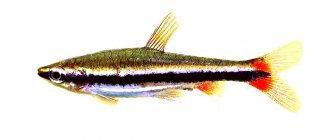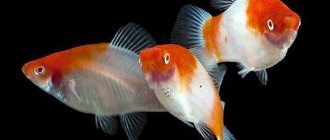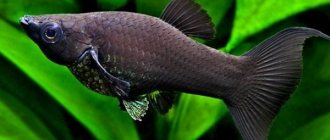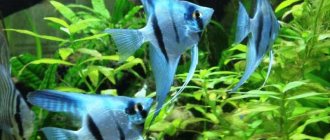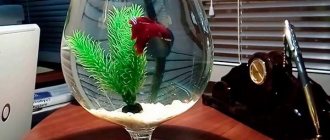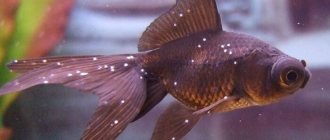Nannostomus mortenthaleri Paepke & Arendt, 2001.
It is one of the most beautiful species of pencilfish.
Synonyms
Russian: Nannostomus marginatus mortenthaleri Paepke & Arendt, 2001
Etymology
Nannostomus: From Latin nannus, meaning "small" and Greek stoma, meaning "mouth", referring to the small mouth parts of members of the genus. mortenthaleri: named after Martin Mortenthaler, who discovered this species.
Family: Lebiasinidae Genus: Nannostomus
Range and Habitat
South America, is endemic to the Nanay River basin in Peru, and has also been found in the Tigre River just to the west.
It lives in canals, small rivers and wetlands, especially in areas with dense aquatic vegetation. Often found in areas of flooded forests and floodplain lakes in areas with “black water”.
Typical habitats are shallow, almost still waters, neighbors are small characinids and dwarf cichlids of the genus Apistogramma.
Care requirements and maintenance of nanostomus
The Nannostomus fish is not at all picky and does not require any special conditions, which is why they love to “populate” it in home aquariums. Fish are highly social, and a couple of fish will not feel very good, therefore. Usually they keep a small flock - from 6 to 12 pieces.
The depth of the aquarium is not important, but the presence of plants in it is very desirable, as is the use of dark, light-absorbing soil. In principle, ideally, the conditions should approximate or recreate the climate of the rivers of South America.
Pictured is Nannostomus nitidus
The water temperature should not fall below 25 degrees and rise above 29. You will also need a peat filter and the installation of diffuse lighting, without which it will simply be impossible to admire the fish.
The pH requirements for water are the same as for other similar inhabitants of aquariums - from 6 to 7 units, and as for the volume of water, 10-12 liters is quite enough for a flock of 12 individuals.
Description
It is one of the most striking members of this genus, being imbued with a striking coral-red coloration throughout the body and fins, which contrasts sharply with the horizontal black stripes.
It can be distinguished from similar species by the following combination of characters: pronounced sexual dimorphism in adult males, having bright red pigmentation between the central and upper (primary and secondary) dark lateral stripes, extending from the tip of the snout to the base of the caudal fin and including the upper part of the iris ; all three dark side stripes are clear and distinctive; central (primary) lateral stripe in males, extends ventrally to the posterior half of the base of the anal fin; the last ray and the posterior margin of the ventral and anal fins are black; the anterior part of the dorsal fin in males is white at the base, red at the tip; adipose fin absent; all rays of dorsal fin are partially black; males with modified thickened anal fin rays.
Size:
Maximum length 25 - 30 mm.
Nannostomus marginatus or Nannostomus marginatus
Nannostomus marginatus or Nannostomus marginatus is very popular among those who like to keep aquariums; it belongs to the Lebiasinidae family, the characinidae order and is the smallest representative. This family includes about fifteen species that are similar in shape and color. They have one common feature - they do not have an adipose fin.
Nannostomus dwarf is considered one of the most miniature and elegant specimens. He has a fairly slender body, his appearance is a bit like a spindle. The jaw is slightly slanted back, the eyes are large. Compared to others, this species has a short body, which is especially enhanced by the transparent fin near the tail.
The body is golden with two dark stripes running along the entire length at some distance from each other. This feature creates the appearance of a golden stripe in the middle, and inside it there is a noticeable streak of rich red color. There is also a stripe that runs along the edge of the abdomen.
The fins are unpaired, except for the caudal one, and have a red tint with a thin edge. The fins located on the abdomen are also red, on the chest they are transparent, and near the tail they are grayish. At night, the fish take on a slightly different color: the longitudinal stripes become lighter, the central one becomes intermittent. But the red color remains on the body and fins.
As soon as Nannostomus marginalatus appeared in modern aquariums, it immediately became popular among aquarists, many of them made its presence mandatory. The reason was as follows: non-standard color, peaceful disposition, small size. In addition, its maintenance and breeding does not require much effort, everything is simple.
These fish were brought to European territory in 1928, they immediately received the name dwarf for their miniature size. They ended up in Russia only after thirty years, at that time aquarists already had a large number of small varieties of fish, and they called the new species for short, that is, marginatus. This species is native to the basins of rivers such as Essequibo and Suriname, located in British Guiana. Here these beauties can be caught in small reservoirs that extend from the main riverbed; the water in them seems very dark due to the many plants hanging over the surface. In natural biotopes, fish mainly stay in small groups near the shores, in the middle of aquatic flora, covered with thickets.
They prefer similar places in aquariums, therefore, tanks intended for breeding Nannostomus marginatus must be planted with vegetation with thin foliage. This can be myriophyllum, cabomba and other species. The fish spend more time among the vegetation, trying to find something edible. They can often be seen near rocks covered with algae. In an aquarium, fish of this species can grow 3-4 cm in size.
Sexual dimorphism
The development of sexual dimorphism, especially in young fish, is expressed to an insignificant extent, rather weakly. Males are somewhat smaller and slimmer in comparison with females; a black edging can be seen on their anal fin; the fins on the abdomen are red, when in females only partial color is observed.
Females have a rounded abdomen, the anal fin has an angular shape, the tip is transparent, and therefore almost invisible. The stripe below is contrasting, black, in males it is somewhat shorter and paler. To correctly determine the gender of a fish, you should not rely only on this feature; for example, some females have an inconspicuous third stripe, while at the same time, there are males with a clearly defined stripe. If a female is constantly pursued by males, then she has reached sexual maturity.
Breeding fish in an aquarium
To maintain and successfully breed a small group, a small tank with a volume of more than forty liters is sufficient. The best option is the presence of dark soil, a moderate amount of vegetation, and plenty of space for fish to swim freely. Nannostomus marginalatus appears to be particularly effective when found in large groups.
The water parameters are not so important; it is enough to fill the tank with water that does not include salts and chlorine. For example, you can get rid of salts if you let the water sit, and you can get rid of chlorine by using any type of water conditioner, then you don’t have to settle it. The most suitable temperature is 23-25°C.
For those who prefer to test water, we present the correct parameters to adhere to: pH in the range from 5.8 to 7.2, highest hardness 15 dGH.
Although this type of fish in its natural environment prefers soft waters, in an aquarium they can easily adapt to hard water. But this is only in the case of keeping: soft water is necessary for the development and laying of eggs. In an aquarium, fish like to stay in groups and move like a miniature torpedo. Trying to find suitable food, they are distributed throughout the tank, however, after a certain period they converge again at one point.
Rivalry often occurs between males and sometimes females, which is noticeable by the fact that they spread their fins and swim close to each other. We can say that nanostomuses are quite resistant to many diseases, but at the same time they are too sensitive to unexpected and sudden changes in conditions.
Newly purchased fish should not be immediately sent to the aquarium; they may die. First, you should adapt them, make sure that they get used to other conditions. It is first necessary to equalize the temperature in the transport tank to that of the aquarium, and then add water from the aquarium gradually, in small quantities. Only after one or two hours can you safely transplant them into the aquarium; the best option is a small separate container. The reason is that purchased fish must be quarantined for one to two weeks, because they can introduce any kind of infection into the aquarium. To ensure a good neighborhood, it is recommended to place related species of these fish as neighbors; you can also send catfish and specimens from the carp family there.
Nutritious diet
Nannostomus marginatus or Nannostomus dwarf has a rather small mouth, therefore it prefers a variety of small crustaceans, daphnia, and cyclops. They also willingly eat bloodworms, small tubifex, and love dry food, for example, TetraDelicaMix, TetraMin Mini, TetraPro.
Breeding
When fish reach puberty, they begin to spawn and this happens throughout the whole year. Their breeding is similar to that of other representatives of the genus, but there is one difficulty: the producers eat the caviar quite quickly and actively. For this reason, protective measures must be introduced. In most cases, to achieve this goal, a separator mesh made of stainless steel or synthetics is used. If there is no mesh, then the bottom of the aquarium is covered with moss of any kind.
Nannostomus can spawn in small containers, even in an ordinary jar with a capacity of three liters. However, the smaller the bottom area, the less caviar remains - the producers quickly find it and eat it. For thirty minutes the caviar is sticky; if it sticks to the cage, there is almost no chance of surviving.
The optimal size of the spawning tank is no less than 40x25x25 cm, such parameters assume a bottom area of 1000 cm2. If the area is large, then it is possible to save the maximum number of eggs and vice versa. The amount of water in the spawning tank should be no more than 10 cm, this will allow the eggs to fall under the net, so the fish will not have time to eat it. In this case, diffused, low lighting should be present.
To ensure spawning, you need the softest water possible, which is usually achieved through distillation and reverse osmosis. With such actions, water hardness can increase to 1-1.5° with the help of magnesium chloride. After the above procedures, the water should be allowed to stand for one week under intense aeration.
Water must be prepared in advance; it must meet the following parameters: hardness 1.5–2.5 dGH, pH 5.5–6.5, temperature 26–28 °C. To acidify water, it is best to use peat extract. It is worth planting for spawning a couple of spawners who made an attempt to lay eggs earlier, when they were in an aquarium with many fish.
It is not difficult for an attentive amateur to discover such a couple; if spawning for them began in a common tank, then it will continue fruitfully in the spawning tank. Another good option is to place one female with two males, and when a pair is formed, simply remove the excess. Before spawning begins, males and females must be placed separately for fourteen days, on a rich and varied diet, while gradually accustoming them to soft water. This can be done by adding it in small parts.
In most cases, spawning occurs in the evening, and spawning occurs in the morning. During this period, the male is especially excited and pursues the female, however, no physical damage occurs - this process can last several days.
The eggs laid by the female are small, once in the water they swell and become much larger in size. When one egg is laid, the female immediately tries to eat it, and the males do the same, but to a lesser extent. Therefore, when spawning ends, the spawners should be immediately eliminated from the tank, and then the spawning substrate should be removed along with the separator mesh. The development period of the embryo can be from thirty to fifty hours, it all depends on the temperature. In particularly soft water, larvae begin to appear around the third day. They do not tolerate light, so the spawning tank should be placed in the shade.
The larvae look like transparent miniature balls with a tail; they simply stay on the bottom for two days, then move to the walls of the spawning tank. At this stage, they acquire a characteristic color, which immediately becomes noticeable.
They have a yolk sac, which helps them survive for several days. When it disappears, the larvae become fry, acquire a length of 3.5 mm, pronounced pigmentation, including dark, light spots, connecting in a thin line throughout the body.
It is not difficult to feed the fry; the initial food is the so-called “live dust”. Since they are slightly mobile, it is necessary to provide them with a large amount of food. They eat all day, pecking food from the walls of the tank or bottom. After three to four days, it is already permissible to introduce special food for Artemia nauplii into the diet. During the same period, it is recommended to add ancistrus to the tank with fry to utilize the remaining food.
It’s worth talking separately about the appearance of the fish’s tail. At the very beginning, it is slightly pointed, has two protrusions - one goes down, the other goes up. The tip is extremely mobile, therefore, in the process of movement, the fry is able to deftly bend.
When about a week and a half has passed, the spine at the end begins to bend upward, the protrusion of the tail at the top disappears, and a rounded blade with a fan-like pattern appears at the bottom instead. At the end of the third week, the tail part begins to clearly emerge with the presence of a lower blade, which increases in size, while the end of the spine protrudes noticeably and takes on the appearance of a bent spike. When the fish turns one month old, the tail noticeably darkens and becomes rounded.
Then you can see the blades, completely transparent, thus marking the “adult” tail. At the same time, the shape of the fins located in the chest area becomes noticeable. The stem is short, with a rounded plate at the end. It has transparent edges, is dark, similar to a fan or hand. This gives the fish an unusual appearance; it immediately catches your eye.
At first, the growth of Nannostomus marginatus fry is slow, however, when they reach a size of 1.5 cm, the growth rate will increase significantly, especially after they are transplanted into a larger container. When the young reach two months, they reach a size of 22−25 mm. Then you can see the formed stripes - golden and black, red spots on the fins. This is the moment when young fish become similar to adults and represent a smaller copy of them.
When they reach three months, they become distinguishable by gender, females are somewhat larger, males have a rounded fin. Their behavior also becomes similar to the behavior of mature fish. When they reach five to six months, the fish can reproduce, this is noticeable by the way they show interest in each other. Dwarf Nannostomus are unproductive; a female that is already noticeably mature can lay eggs around the eggs for spawning. However, upon completion of spawning, a small amount of eggs from the clutch remains.
Such drastic measures as the use of a large spawning tank, which is completely filled with vegetation with small foliage, are not considered effective. Also, you should not change the substrate with the presence of stuck eggs to another during spawning.
Until now, no practical and effective way to preserve caviar has been invented. Therefore, one couple will provide twenty to thirty fry per spawning - this is a good result, and forty to fifty is the best.
Due to difficulties in breeding and low productivity, Nannostomus marginalatus is not classified as a commercial species. They are rarely found in modern aquariums today, although they are suitable for keeping in nano-cubes, which are popular.
Behavior and Compatibility
It is a very attractive, peaceful and active aquarium fish. An excellent addition to a community aquarium containing other small, peaceful fish. Should be kept in a group of at least 6 fish.
Males of this species can be aggressive towards each other, but usually without serious consequences, so it is best to keep as many as possible to disperse the aggression. When keeping a flock, there should be more females than males. Fortunately, they are not aggressive towards other fish species.
Buy as many as possible from 10 or more, since with this quantity the fish are more active and less shy, more often visible and have better coloring, and exhibit more natural behavior.
Nutrition of Nannostomus
When it comes to food, these nimble tropical chameleons are not at all picky and will eat whatever is given to them. However, you need to feed the fish little by little, the amount that they eat at a time, since they will only pick up food at the bottom if they are very hungry, which is practically unattainable at home.
They love live food very much:
- coretra (small);
- Daphnia;
- Cyclops;
- Artemia;
- small worms;
- bloodworm;
- diaptomus.
When keeping Nannostomus Beckford, it is sometimes worth giving a hard-boiled egg yolk - these fish simply adore it. They feel great when fed balanced dry mixtures for aquarium tropical fish.
Aquarium
Basic sizes from 90 * 30 cm or equivalent if you want to contain a group.
An aquarium with dense thickets of aquarium plants and places for swimming, preferably dark, fine-grained soil, branched snags. Floating plants are a useful addition.
A species aquarium with weak filtration; in most cases, installing only an air filter is sufficient.
Water parameters:
Temperature: 24 – 28°C pH: 4.0 – 7.0 Hardness: GH 2-10°
Regular water changes, at least 25 - 30% every two weeks.
This species requires stable conditions and should not be added to an immature aquarium.
Nannostomus fish species
Although scientists have counted 40 varieties of Nnanostomus in nature, and confidently declare that there are more of them than those that were able to be isolated and described, the following have settled in aquariums:
- Nannostomus Beckford
The most famous and beautiful view. Grows up to 6.5 centimeters. Basic colors are greenish, bluish, with gold or silver. But the fish changes its shades very quickly.
Pictured is Beckford's nannostomus
There is also a dwarf subspecies - Nannostomus marginatus , its length does not exceed 4 cm. The sides of these fish are decorated with two longitudinal stripes - gold and dark turquoise. However, the dark band is visible mainly at night.
- Nannostomus red
This is the same Nannostomus Beckford , which has a red base color of scales. In different lighting it shimmers with all the colors of the fire element. It is not demanding in terms of nutrition, and unlike its other “relatives” it is very susceptible to the presence of oxygen in the water. The combination of classic Nanostomus Beckford and red looks incredibly beautiful and very decorative.
In the photo, Nannostomus red
- Nannostomus mortenthaler
These fish came to aquariums from Peru. Their main difference from all other species is, of course, their color, which consists entirely of longitudinal stripes, mainly a bloody red hue, alternating with a deep coffee tone. The picture is complemented by fins, colored in half, in the same tones as the scales themselves.
Pictured is Nannostomus Mortenthaler.
These fish became famous only after 2000, and immediately populated aquariums. They are completely unpretentious, tolerate any lighting, are immune to slight changes in the chemical composition of water and do not require a large area. They feel good in round aquariums, and due to their size - from 2.5 to 4 cm in length, they can also be kept in large schools in a small capacity.
- Nannostomus aripirangis
This is still the same, Nannostomus Beckford, the subspecies differs in color. Along the entire body of the fish there are three clear stripes - two dark and between them a light one. The rest of the scales shimmer in all possible shades and change depending on the situation and time of day, and in home conditions - on the lighting.
In the photo is Nannostomus aripirangis.
Unlike their relatives, they are very mobile and need a large aquarium. A school of 10-12 fish will need 20-25 liters of water. It is also necessary to regularly replace at least a third or a quarter of the water with fresh water. This variety does not tolerate stagnation in the aquarium.
Breeding
Under favorable conditions in the aquarium, fry may appear without your participation.
If you want to increase their numbers, a slightly more controlled approach is required.
Before placing these fish in a breeding aquarium, the males and females should be separated a few days before. Increased feeding of live food increases readiness for spawning.
Prepare one or more small spawning tanks filled with settled water. Fill most of the open space with small-leaved plants or artificial substrate.
No lighting or filtration is needed, although you can install a small sponge air filter if you prefer.
Once the growers are prepared, one or more pairs can be planted in each container.
When using more than one pair, arrange the plants or artificial fibers in such a way that separate territories are created, for example, with two pairs, place the spawning substrate in different areas of the aquarium with a gap in between.
Adults can be removed after 2-3 days, and the first fry should be visible after a day or two.
If you are using artificial fibers as a spawning substrate, an alternative method is to check them daily, removing and replacing as you find eggs and raising the fry elsewhere.
The starting food can be rotifers and ciliates, then as the nauplii grow, Artemia.
The pattern of adult fish appears after 8 weeks or so.
Life expectancy is about 5 years.
Compatibility of Nannostomus with other fish
Nannostomus are very sociable and absolutely friendly fish. They get along well with all members of their own family, as well as with any other non-predatory fish.
When keeping different inhabitants of an aquarium together, two simple rules must be followed - all inhabitants of the water space must need the same conditions and everyone must have enough space, light and food.
Feed and feeding
Red Nannostomus are omnivores. Although in their natural habitat they feed primarily on tiny invertebrates and other zooplankton, fish in an aquarium will generally eat any food item. Nannostomus are not picky eaters, so they will eat small granules, flakes, and freeze-dried foods. They will happily feast on brine shrimp (live or frozen), as well as small worms. Keep in mind that the mouths of red nannostomus are very small, so food will often have to be crushed in order for them to eat it.
It is advisable to feed red nannostomus several times a day in small portions.
Diseases
Red nanostomus is predisposed to infection by protozoan microorganisms, especially during the acclimatization stage; health problems also arise when water parameters change sharply or when permissible levels are exceeded. Read more about symptoms and treatment methods in the section “Diseases of aquarium fish”.
Peculiarities
- Small fish size, no more than 3 cm.
- Intraspecific aggression among males
- Small feed required
- Can jump out of the aquarium
- School keeping of at least 6 individuals
